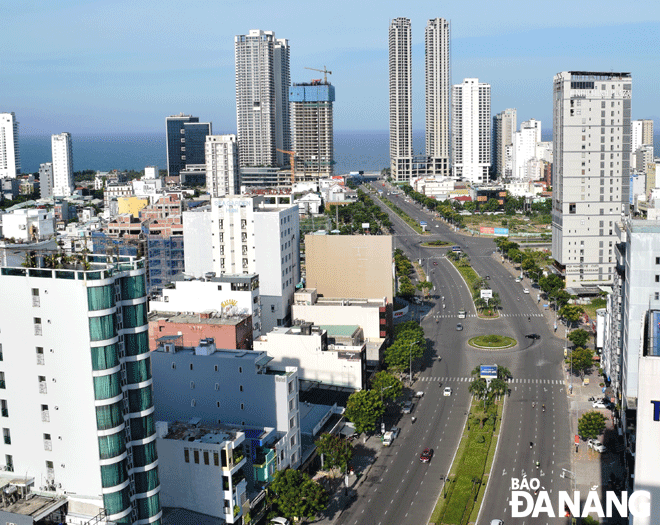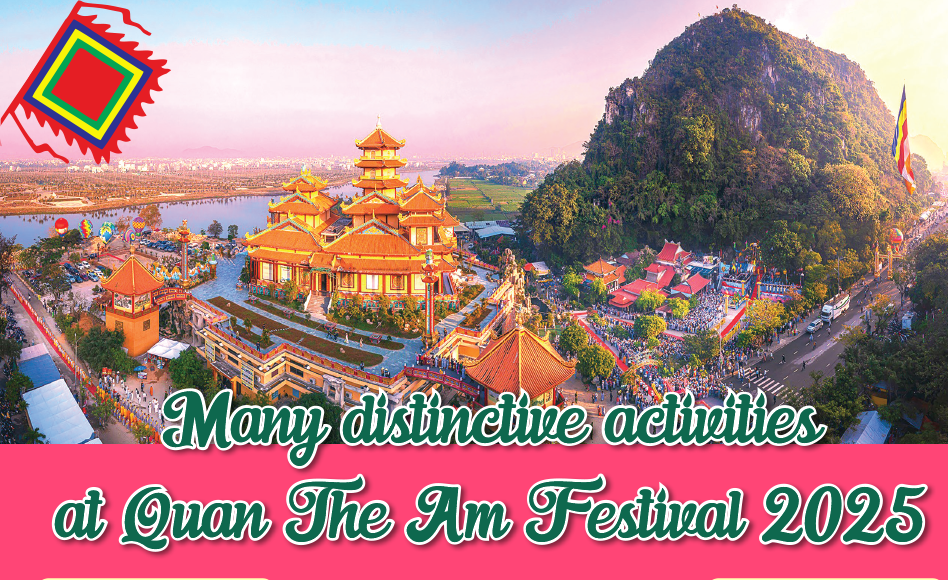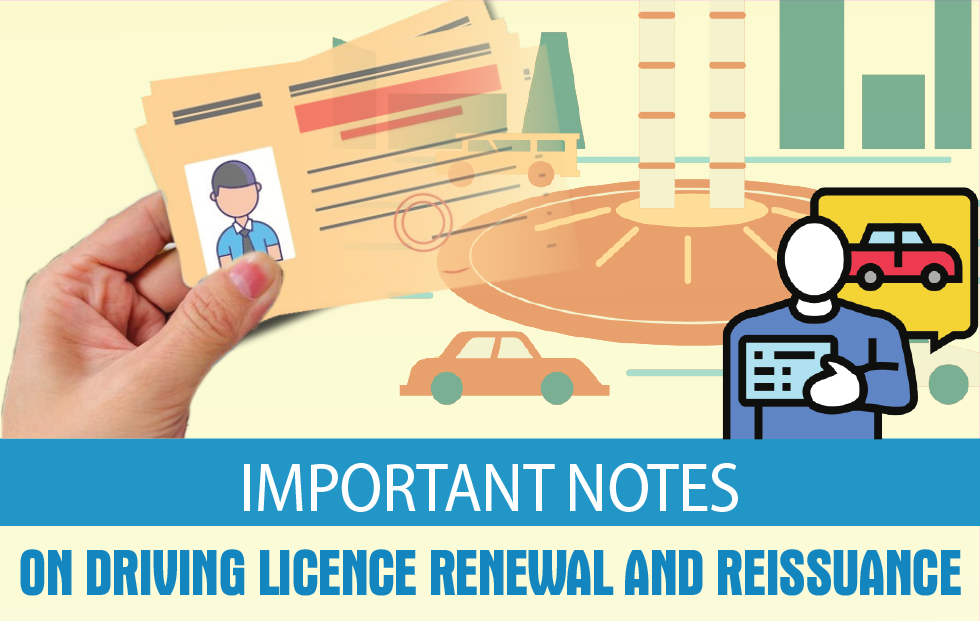Da Nang focuses on environmental protection for sustainable development
Da Nang’s draft planning for the 2021-2030 period, with a vision to 2050 which has been already submitted to the Prime Minister for approval identifies its development perspectives. Focus is paid to building urban ecological areas, preserving nature and protecting the environment while driving the city’s socio-economic development in association with ecology and environmental protection.
 |
| Da Nang is exerting every effort to become one of best coastal cities in Asia. Photo: HOANG HIEP |
Source water protection
In its efforts to ensure water quality in the Cu De River before the Hoa Lien Water Plant is put into operation, the Hoa Vang District Office of Natural Resources and Environment in mid-March worked with the Hoa Bac Communal People's Committee, and the Hoa Vang District Environmental Enterprise to place trash bins at many points along DT.601 road (the section from the Nam My Dam to the villages of Nam My, Gian Bi and Ta Lang in Hoa Bac Commune. A garbage truck then appeared in the three villages for the first time to empty rubbish from these bins to transport them to the Khanh Son landfill. Garbage bins and garbage trucks are a common sight in the city but residents of the three villages have waited for such a thing for a long time. These villages are the last ones of Hoa Vang District to have household waste collected.
At that time, even though it was the middle of the week, many officials and residents of Gian Bi village were active in participating in environmental cleanups to pick up trash and rubbish scattered on the roads and the Guol house 's yard for garbage truck collection to transport them to the Khanh Son landfill in a bid to keep their villages clean and beautiful, contributing to the protection of source water in the Cu De River.
Mr Thai Van Hoai Nam, the Chairman of the Hoa Bac Communal People's Committee said: "the commune’s officials and people are paying special attention to protecting drinking water sources through their involvement in many practical actions. Included are protecting and preserving forests, stopping the destruction from illegal gold mining, planting timber forests, and collecting household waste in the remaining villages of the commune”.
Mr Nam also asked for more attention from the municipal government to build wastewater collection and treatment systems in new and existing residential areas in attempt to guarantee the quality of the treated wastewater before discharging into the Cu De River.
According to the Da Nang Department of Natural Resources and Environment, more than 88% of the total volume of wastewater daily generated by the city’s households is currently collected and treated. Total operational capacity of wastewater treatment plants across the city will reach 340,500 m3 per day after plants under construction will be put into operation in 2023. Unlike urban areas in the city, Hoa Vang Rural District finds it very hard to build wastewater collection and treatment systems due to its scattered residential areas, and topography-driven isolation. Hence, small and scattered wastewater treatment plant in each residential area and urban area in Hoa Vang District is appropriate to the development of new residential areas and urban areas for source water protection.
“We are paying special attention to building small wastewater treatment plants in new resettlement areas in Hoa Vang District, especially in Hoa Bac, Hoa Khuong, Hoa Phu communes in the coming time.”, said Director of the Da Nang Management Board of Traffic Work Construction Investment Projects Nguyen Minh Huy.
Da Nang’s draft planning for the period 2021-2030, with a vision to 2050 identifies the city’s drainage plan in the immediate future with a focus on building small and scattered wastewater treatment plants in Hoa Vang District. The city will invest in building new wastewater collection and treatment systems in order to increase the total operational capacity by 2030 to 515,000m3 per day. Heed will be paid to increase the capacity of the Lien Chieu Wastewater Treatment Plant by 50,000m3 per day, building new Hoa Nhon Wastewater Treatment Plant with a design capacity of 80,000m3 per day, building scattered and localized wastewater treatment plant with a total capacity of 45,000m3 per day in the southwest part of the city.
Building an eco-friendly city
The Da Nang government-approved project to develop Da Nang into an eco-friendly city in the 2021-2030 period sets out special incentive criteria to successfully implement the city’s goals. By 2030, the city will be home to 2-3 eco-industrial parks; 5 urban ecological areas, reduce greenhouse gas emissions by 5-7% with the uptake of renewable energy generation while the rate of wastewater recycled and reused in the city will reach 20%.
Da Nang’s draft planning for the period 2021-2030, with a vision to 2050 also sets its general goals to develop Da Nang into an eco-friendly and livable city by 2030, and one of best coastal cities in Asia by 2050. By 2030, 90% of the total volume of wastewater generated by the city’s households will be collected and treated to meet environmental technology standards while all dedicated production, trading and service areas, along with industrial clusters will install their own wastewater treatment systems to meet required standards. Besides, 100% of the city’s population will have access to safely managed drinking water services while its air quality index (AQI) values will be below 100 which are generally thought of as satisfactory. Furthermore, the city’s forest coverage will reach 45-47% while per capita public green space will be 9m2 in the inner-city. Moreover, more than 97%, of daily-life solid waste at homes will be collected and treated to meet environmental technology standards while the rate of buried treated waste will not exceed 20% and that of the city’s hazardous waste collected and treated will reach 100%.
According to the municipal Department of Natural Resources and Environment, in its efforts to achieve the above goals, the city will continue to perfect its urban environmental infrastructure, including waste transfer stations and waste treatment complex equipped with advanced technology. In addition, the city will strengthen measures to manage and improve the quality of the air, water, soil, river basins and marine environment. Importance will be attached to promoting the implementation of projects to treat surface water in ponds, lakes, rivers and canals in urban areas and residential settings. Special attention will be given to developing a circular economy vision and circular economy business models, reducing greenhouse gas emissions, developing renewable energy and increasing its uptake, developing strategies for the conservation and sustainable use of biological diversity, enhancing conservation efforts for protected areas, as well as expanding conservation areas, protecting and restoring the city’s important ecosystems. High priority will be given to launching awareness raising campaigns to call for public engagement in protecting the environment, and keep our environment green, clean, beautiful and safe.
Reporting by HOANG HIEP – Translating by H.L








